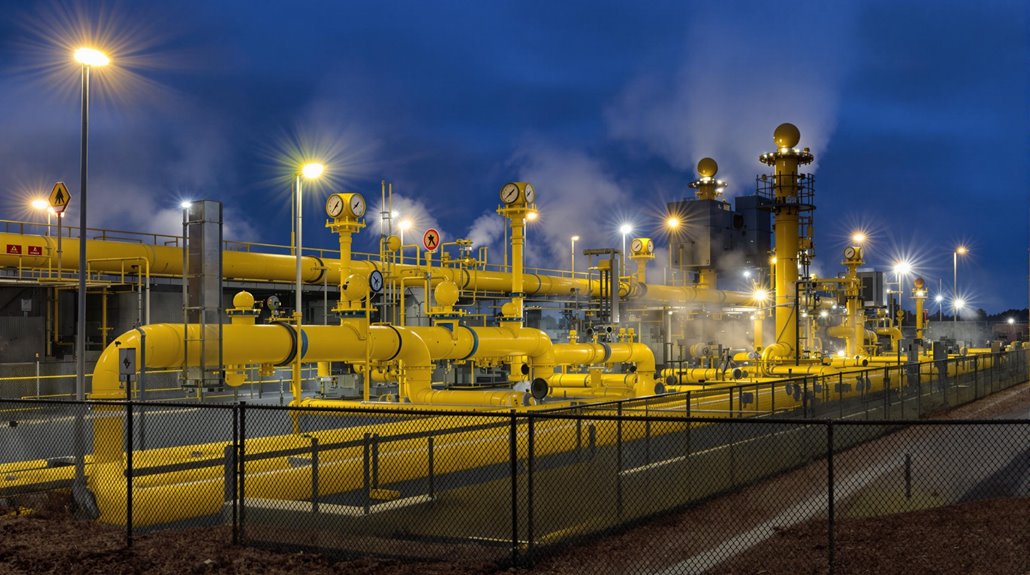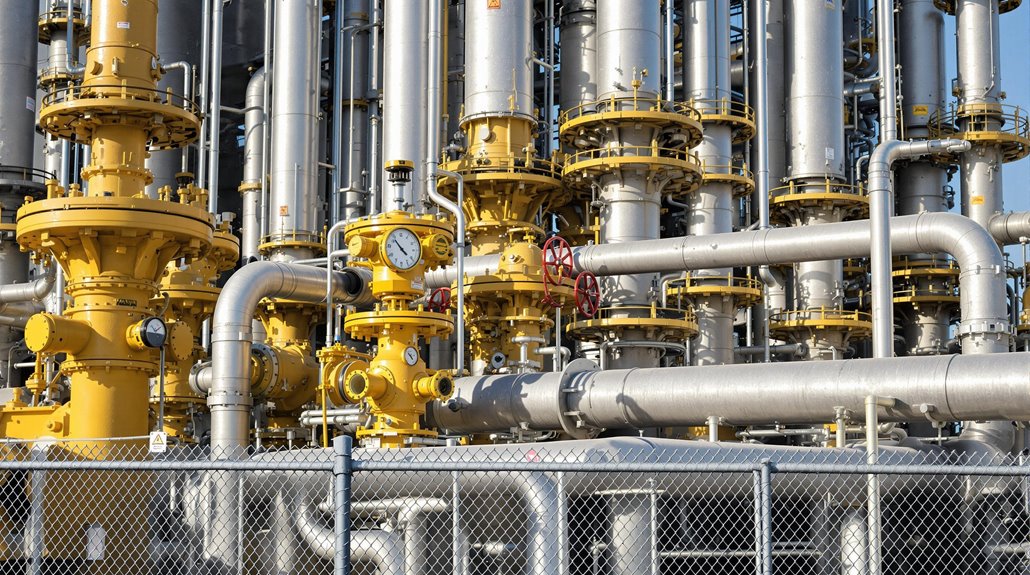What Are City Gate Stations and Their Important Role in Natural Gas Distribution?

City gate stations serve as critical handoff points where high-pressure natural gas transitions from transmission pipelines to your local distribution network. You'll find these facilities equipped with essential components like pressure regulators, heaters, and metering systems that guarantee safe gas delivery to homes and businesses. They maintain precise measurements while reducing pressure to appropriate levels for distribution. Understanding these indispensable facilities helps reveal how natural gas safely reaches your community.
Understanding City Gate Stations in Natural Gas Networks
As natural gas travels from major transmission pipelines to local distribution networks, city gate stations serve as critical handoff points that regulate pressure and assure safe delivery. You'll find these stations operating as indispensable interfaces where high-pressure gas from transmission pipelines meets your local distribution system.
When natural gas reaches a city gate station, it undergoes pivotal pressure regulation, dropping from several hundred psig to less than 300 psig for safe distribution. The stations house essential equipment like heaters, pressure regulators, and odorant injection systems to properly condition your gas supply. They're also equipped with precise metering facilities to measure gas volumes accurately. These transfer points guarantee you receive properly pressurized natural gas through your local distribution network while maintaining consistent delivery standards and safety protocols.
Similar to how current electricity requires a closed circuit for continuous flow, natural gas distribution systems need uninterrupted pathways to maintain steady delivery to end users.
Key Components and Surface Facilities
While city gate stations may appear complex from the outside, their core components work together in a straightforward system to process incoming natural gas. The key components you'll find at a city gate station include metering runs, heaters, and pressure regulating equipment that work together to prepare gas for local distribution.
The pressure regulating system serves a critical function by reducing gas pressure from transmission pipeline levels of several hundred psig to safer distribution system pressures below 300 psig. You'll also find essential surface facilities that include downstream pressure regulators and odorant injection equipment. These components guarantee the gas meets local distribution requirements.
Companies like EN-FAB have extensive experience designing and manufacturing these indispensable station components, demonstrating their importance in gas distribution infrastructure. Similar to how rechargeable battery packs provide reliable backup power during outages, these station components ensure consistent gas delivery to end users.
Pressure Regulation and Safety Controls

Because safe gas delivery depends on precise pressure control, city gate stations incorporate multiple layers of regulation and safety systems. You'll find downstream pressure regulators that reduce gas pressure from transmission line levels of several hundred psig to distribution pressures below 300 psig. This indispensable pressure regulation process requires heaters to offset temperature losses during gas expansion.
The station's safety equipment and components include emergency shut-off valves and pressure relief devices that protect against system failures. You'll also see various control elements like pipes, valves, flanges, fittings, meters, and pneumatic controllers working together to monitor and manage gas flow. IoT-enabled systems now perform automated self-tests and report issues to minimize manual safety checks. These integrated safety and regulation systems guarantee reliable operation at this pivotal junction between high-pressure transmission lines and your local distribution network.
Metering and Measurement Systems
The metering and measurement systems at city gate stations work alongside pressure regulation equipment to guarantee accurate gas transfer from transmission pipelines to local distribution networks. These critical systems verify you're receiving the correct amount of natural gas supply while maintaining proper pressure levels below 300 psig, down from the higher transmission pipeline pressures.
At each City Gate station, sophisticated metering packages monitor and measure the flow of gas as it moves from high-pressure transmission lines into your local distribution system. Companies like EN-FAB have demonstrated competence in designing and fabricating these essential measurement systems, as demonstrated by their work in Colombia and recognition in NIPER-580. This precise metering capability helps utilities track and manage gas flow, verifying reliable service and accurate billing for customers. Similar to how active power in electrical systems is measured in watts to determine useful energy output, these gas metering systems measure the actual volume of natural gas delivered to end users.
Local Distribution Network Integration

From the moment natural gas enters a city gate station, local distribution networks take on the indispensable role of supplying this energy source to homes, businesses, and industrial facilities throughout their service territories. You'll find that these local distribution companies manage the vital transition between high-pressure transmission pipelines and the smaller gas pipelines that serve your community.
In the Gas Industry, this integration point represents where wholesale markets meet retail distribution. The infrastructure you rely on connects seamlessly with major transmission systems, allowing for controlled pressure reduction and efficient delivery to end-users. You're benefiting from a carefully regulated system where local distribution companies must maintain safety standards while guaranteeing fair pricing. This integration guarantees you receive reliable natural gas service through a well-coordinated network of infrastructure.
Regulatory Requirements and Quality Standards
Since public safety remains paramount in natural gas distribution, regulatory bodies impose strict requirements on city gate stations and local networks. You'll need to comply with strict quality control standards that govern pressure regulation, typically maintaining specific pounds per square inch levels throughout the natural gas pipeline system.
Regular component analysis of equipment components is essential to meet regulatory requirements. You must perform routine inspections of pressure regulators, meters, and safety shut-off devices to guarantee they're functioning correctly. These inspections help prevent gas leaks and maintain system integrity. You're also required to monitor gas quality parameters, including moisture content, heating value, and odorant levels, to certify the gas meets federal and state specifications before it enters the distribution network.




